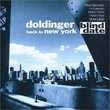| All Artists: Gustav Mahler, Leonard Bernstein, New York Philharmonic, Joseph Alessi, Glenn Dicterow, Christa Ludwig, New York Choral Artists, Brooklyn Boys Chorus Title: Mahler: Symphonie No. 3 in D Minor Members Wishing: 1 Total Copies: 0 Label: Deutsche Grammophon Release Date: 7/20/1989 Genre: Classical Styles: Opera & Classical Vocal, Symphonies Number of Discs: 2 SwapaCD Credits: 2 UPC: 028942732827 |
Search - Gustav Mahler, Leonard Bernstein, New York Philharmonic :: Mahler: Symphonie No. 3 in D Minor
 | Gustav Mahler, Leonard Bernstein, New York Philharmonic Mahler: Symphonie No. 3 in D Minor Genre: Classical
Leonard Bernstein more or less owned this symphony, and both this and his earlier Sony recording are superb. He was one of the few conductors who wasn't afraid of the musical insanity that Mahler unleashes in the first mov... more » |
Larger Image |
CD DetailsSynopsis
Amazon.com essential recording Leonard Bernstein more or less owned this symphony, and both this and his earlier Sony recording are superb. He was one of the few conductors who wasn't afraid of the musical insanity that Mahler unleashes in the first movement (a collision between two marches of very different character), and the New York Philharmonic is one of the few orchestras in the world with the stamina to carry the whole thing off. This is the longest symphony ever written that's in the international repertoire, but listening to Bernstein's way with it, you'd never guess. This recording is also included in DG's magnificent box set of the complete Mahler symphonies. --David Hurwitz Similar CDs
Similarly Requested CDs
|
CD ReviewsMahler's other masterpiece. A. Michaelson | 06/20/1999 (5 out of 5 stars) "Mahler's Third Symphony is the biggest of the ten (in length, at least), and, it seems to me, probably the least performed. Whether that has to do with it's duration (100+ minutes) I'm not sure, but it is surely one of Mahler's most magnificent works. Leonard Bernstein is the Mahler Master, if there ever was just one, and the New York Philharmonic is as great a Mahler orchestra as any, especially with Lenny. The first movement is a bear; more than twice as long as the second and third movements combined. The Philharmonic performs splendidly through the section, culminating in a very energetic flourish. The third movement is harrowingly ironic, and Ludwig sings the fourth as darkly as anyone. The fifth movement, with it's treble choirs (female & children's voices) stands in stark contrast to the preceding one with it's up-beatness. The massive 6th movement is one of Mahler's finest creations: a solemn, religious Adagio that evolves from a gorgeous melody into a glorious hymn. It's something you have to hear, rather than read about." A Mahler's Third for the ages A. Michaelson | Bay Area, CA | 08/09/2003 (5 out of 5 stars) "Mahler's Third is a very difficult piece to play and understand. Not only is the longest symphony in the standard repetoire, it also showcases Mahler's desire to show the entire universe in a symphony. There are more contrasts between light and dark, happy and sad, loud and soft, fast and slow, etc, in this symphony than in any other Mahler symphony. It makes this symphony a very difficult piece to listen to, and perhaps Mahler's most inaccessible for the casual listener or Mahler novice. That said, one must still agree that Bernstein gives this symphony a reading that is simply unforgettable. Bernstein manages emphasize the essential contrasting elements of the music, especially in the seemingly endless first movement, and keep the listener at the edge of his seat from the tension and emotion Bernstein elicits. Plus, this recording has excellent sound. Some of the best I've heard, in fact. The explosions are more explosive than in any other recording I've heard. It's something you have got to hear for yourself! I've grown to love this symphony and now it's one of my favorites; however, without this recording, who knows how positively I'd feel about this difficult (yet very fulfilling) composition." Mahler creates a massive world... ewomack | MN USA | 08/08/2005 (4 out of 5 stars) "What a huge symphony. It's enormous. Both discs of this recording together run approximately an hour and forty-five minutes (64'12 + 41'40). Throughout this seemingly impossible span the melodic themes intertwine like celtic knots, the dynamics range from a whisper to a SCREAM, and along the way we meet Friedrich Nietzsche, a solo vocalist, and a boys choir. Leonard Bernstein and the New York Philharmonic pelt this one out with gusto, but some listeners have complained that Berstein meddles too much with the production (the symphony does balance on the fence of melodrama in places, and a steady guide needs to keep it from tipping into the mushy goo on the wrong side). The recording overflows with full lush strings and horns throughout giving it a very dramatic texture. It's not a piece or a recording suited for background music. It demands attention.
Six movements (in two parts) spontaneously and linearly create Mahler's symphonic world. Mahler originally drew up program notes to go along with the work's multifarious parts (with titles such as "Pan Awakes", "What the Animals in the Forest Tell me", "What the Angels Tell me", and "What Love Tells me"), but he later abandoned them as too stringent. He didn't want to shove his interpretation down the throats of his audience and stifle the carte blanche experience of listening. The first movement (composed in 1896, a year after the following five movements) opens with a triumphal imposing horn blasting melody. Allusions to Brahms and Wagner lurk beneath the melodies and harmonies. The movement itself is as dynamic as the entire structure of the symphony. From loud and garrulous to near silence, the movement marches and trunches forth while throwing some diversions here and there along with some lovely solo violin speckles. This movement alone makes up Part I of the symphony. The remaining movements make up Part II. The second movement opens in great contrast to the first. A lonely but danceable horn melody leads us into a beautiful minuet which later transforms into downright danceable and bouncy music. It eventually flutters out with strings. Next, in the third movement, some shades of the "nature sounds" of Mahler's first return. A "cuckoo" whistles and the orchestra performs some dramatic loopty-loops before breaking out into full song. Musical hints of birds flitter everywhere in this movement. It ends with a clenching creshendo buildup and finally with an unmistakable, almost shocking, bang. Over an hour of music passes between the beginning of the work and the first vocal movement (the fourth). Here Mahler puts to music the "Midnight Song" from Nietzsche's "Thus Spake Zarathustra". Following the bang of the previous movement, Mahler treats us to a tense painfully beautiful song. Nietzsche was still alive while Mahler composed this symphony, though he had fallen into his "famous" madness (he died in 1900). Mahler also apparently had some regard for Nietzsche -at one point he was going to name the entire symphony after Nietzsche's 1882 work "The Gay Science". Once again, in great contrast, the next song (and the work's shortest movement at only slightly over 4 minutes) gives off a joyous feeling. The boy choir even chants happy bell sounds. And then the big finale. The sixth and final movement. A painfully beautiful buildup of some twenty minutes brimming with juicy strings and a few explosions precedes the final thumping drums and majestic climax. It contrasts greatly with the symphony's first mostly raucous movement. And here's another of Mahler's big endings. The sixth movement as a whole provides a stunning conclusion to the piece. Mahler's Third Symphony is simply overwhelming. It's as difficult to get one's mind around as it is to get one's arms around an aircraft carrier. It's a hulk, a behemoth. But it's also amazing and more than worth the numerous listens required for the symphony to begin to reveal its nuances and hidden gems. Did Mahler attempt to reflect life itself in this gargantuan work? Does that explain its complexity and size? Possibly, but regardless of how one interprets it, the work is full of great Mahlerian music that doesn't require picky granular analysis to enjoy." |

 Track Listings (17) - Disc #1
Track Listings (17) - Disc #1











